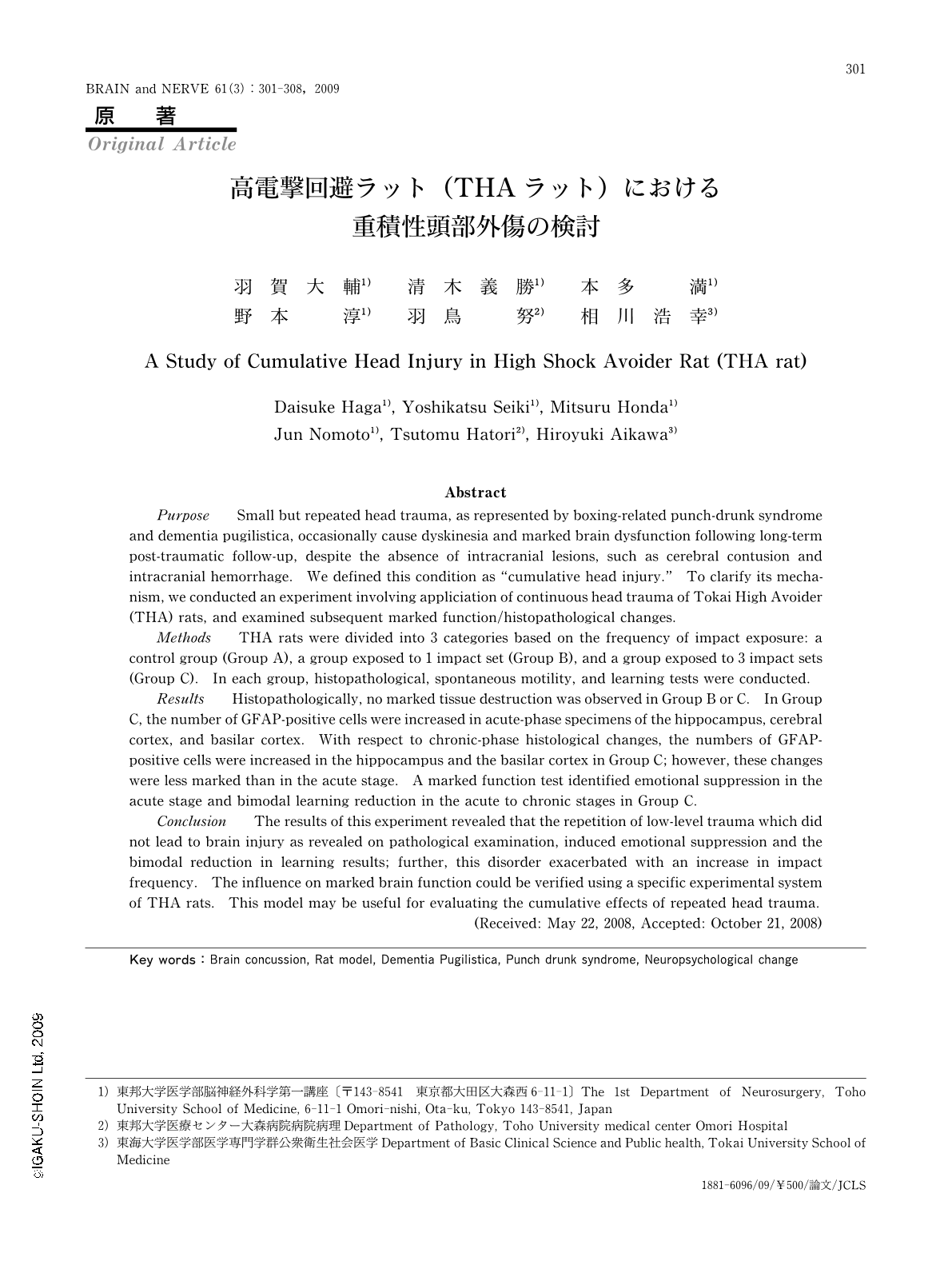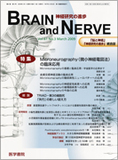Japanese
English
- 有料閲覧
- Abstract 文献概要
- 1ページ目 Look Inside
- 参考文献 Reference
はじめに
近年,頭部への軽微な衝撃が繰り返し加わった結果,脳挫傷や頭蓋内出血などの明らかな病変がないのにもかからず,長期間を経て運動障害や高次機能障害などを起こす病態が注目されている。周知のものとして,ボクシングにおけるpunch drunk syndrome(PDS),dementia pugilistica(DP)が挙げられ1-4),retrospectiveな評価では,17~50%のボクサーに認められるとの報告もある5)。近年ではサッカー選手の反復するヘディングが原因と考えられる,後発性の記憶障害や認知機能障害などの報告も散見される6,7)。しかし同病態が長期間にわたって緩徐に進行するため剖検例や組織検体が少なく,さらには特徴的な症状である高次機能障害の評価が実験動物では困難であることなどの理由から,現在においても十分な基礎的研究がなされていない。
筆者らは本病態のように,①軽微な頭部外傷の繰り返しにより発生し,②明らかな頭蓋内病変を認めないにもかかわらず,後に高次機能障害や運動障害などの種々の神経症状を呈する頭部外傷を「重積性頭部外傷」と定め,同実験モデルの作製と病態解明を目的として,頭蓋振盪実験後の高電撃回避ラット(THAラット)における高次機能や病理組織の変化から検証を行った。
なお,本研究にあたっては東邦大学・東海大学動物実験委員会の承認を得ている。
Abstract
Purpose Small but repeated head trauma, as represented by boxing-related punch-drunk syndrome and dementia pugilistica, occasionally cause dyskinesia and marked brain dysfunction following long-term post-traumatic follow-up, despite the absence of intracranial lesions, such as cerebral contusion and intracranial hemorrhage. We defined this condition as "cumulative head injury." To clarify its mechanism, we conducted an experiment involving appliciation of continuous head trauma of Tokai High Avoider (THA) rats, and examined subsequent marked function/histopathological changes.
Methods THA rats were divided into 3 categories based on the frequency of impact exposure: a control group (Group A), a group exposed to 1 impact set (Group B), and a group exposed to 3 impact sets (Group C). In each group, histopathological, spontaneous motility, and learning tests were conducted.
Results Histopathologically, no marked tissue destruction was observed in Group B or C. In Group C, the number of GFAP-positive cells were increased in acute-phase specimens of the hippocampus, cerebral cortex, and basilar cortex. With respect to chronic-phase histological changes, the numbers of GFAP-positive cells were increased in the hippocampus and the basilar cortex in Group C; however, these changes were less marked than in the acute stage. A marked function test identified emotional suppression in the acute stage and bimodal learning reduction in the acute to chronic stages in Group C.
Conclusion The results of this experiment revealed that the repetition of low-level trauma which did not lead to brain injury as revealed on pathological examination, induced emotional suppression and the bimodal reduction in learning results; further, this disorder exacerbated with an increase in impact frequency. The influence on marked brain function could be verified using a specific experimental system of THA rats. This model may be useful for evaluating the cumulative effects of repeated head trauma.
(Received: May 22,2008,Accepted: October 21,2008)

Copyright © 2009, Igaku-Shoin Ltd. All rights reserved.


